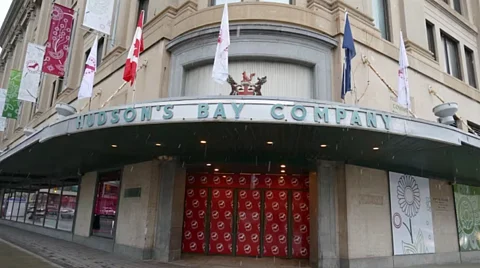

For more than 350 years it's been Canada’s oldest corporate entity and one of the country’s most recognizable retail brands.
Now the Wall Street Journal is reporting that the Hudson’s Bay Company is preparing to file for bankruptcy within days, citing anonymous sources.
If so, the move would mark a dramatic downfall for a company that traces its roots back to 1670, pre-dating Confederation by nearly two centuries.
Hudson’s Bay was more than just a department store — it was an institution that shaped Canada’s history, from its origins in the fur trade to its role in Western expansion. The company once controlled vast swaths of land, operated its own trading posts, and even issued its own currency.
But in recent years, it has become another casualty of shifting consumer habits, the rise of e-commerce, and financial mismanagement.
Once a dominant force in Canadian retail, HBC had been struggling for years under American ownership, closing stores and battling landlords over unpaid rent, reportedly worth more than $20 million per month.
In response, HBC took the unusual step of suing its landlords, arguing that they failed to maintain “first-class” shopping malls during the COVID-19 pandemic.
After its 2024 decision to acquire Neiman Marcus — which had gone bankrupt in 2020 — and spin off the Canadian chain as a stand-alone business, it now appears unable to survive a rapidly shifting retail landscape.
Warning signs emerged after the deal closed in December of 2024, when the HBC parent company tapped the junk bond market to finance it.
In January, The Bay laid off 41 employees, citing “challenging headwinds” and began closing stores in Vancouver and Ontario. The company confirmed another round of layoffs last week, part of what it called a “revamp” in response to ongoing retail challenges.
The iconic Banff store closed last year.
The retailer laid off about one per cent of its workforce last April and then carried out an unspecified number of cuts in the summer, when its parent company HBC prepared to spin out some of its US brands into a new entity called Saks Global, which includes chains like Macy’s and Saks Fifth Avenue.
Meanwhile, the new standalone Bay had reportedly been unable to pay for repairs and maintenance to things like escalators in its stores, including Calgary — even though its real estate portfolio of heritage buildings in major Canadian cities is reportedly worth more than $2 billion.
Hudson’s Bay now faces the same fate as other once-dominant Canadian retailers that have disappeared in recent decades. T. Eaton Company Limited filed for bankruptcy in 1999 while Sears Canada collapsed in 2018.
It’s not clear what the fate of the company’s 2,200 employees and heritage buildings will be, although some have speculated the name will live on in some form, if only to keep anchor tenants in major malls.
Former Premier Jason Kenney posted on Twitter (“X”): “Terribly sad. HBC is a central part of Canadian history. The oldest Canadian company, and one of the oldest in the world. Thinking today of the thousands of Canadians who work there. Hopefully Canadian owners can buy at least the brand and some of the assets out of bankruptcy to keep the legacy alive.”
